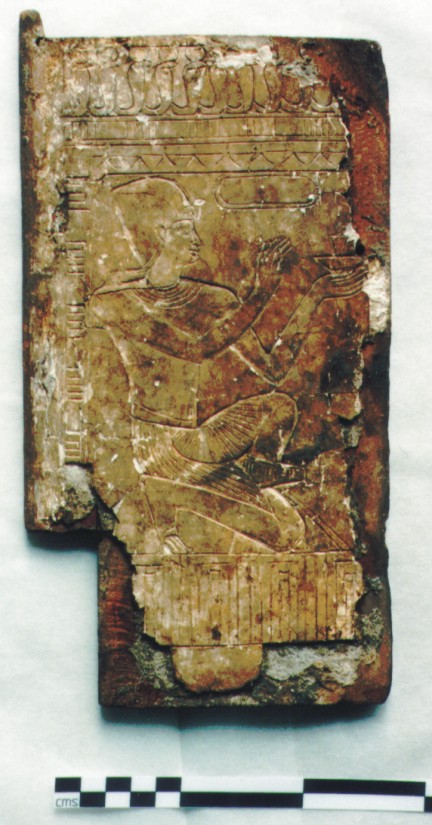EC485
EC485 Door of a shrine

Door cover of a shrine. This is made from wood with modelled gesso (plaster) and would originally have been gilded. The hinge is on the left hand side. The shrine would have held an image of a god. The decoration shows a king wearing the Blue Crown and kneeling to offer to the statue within the shrine.
The king is kneeling, facing right and offering incense with his left arm. He wears a shendyt kilt and the blue (khepresh) crown. This crown goes out of use in the 25th Dynasty (Collier 1993) but is brought back by Saite (Russman 1995) rulers (from 664 BC) and used by later kings. It was often worn when the king was shown offering. In front of the king’s head is a cartouche, but unfortunately the name therein cannot be read. Above the figure is a pt (sky sign) with a row of stars therein and uraei. Stars are also featured on the Late Period naos of Amasis, Louvre E605). Below the king is a row of doors evoking early royal palace facades (also featured on the naos of Amasis, Louvre E605 and the naos of Darius, British Museum EA37496). This façade decoration is also seen on earlier shrines such as the sides of the small golden shrine of Tutankhamun.
Ideologically, only the king offered to the gods, though in reality priests and others did too.
The king stood halfway between his people and the gods. This meant that the king mediated between the two. It was he who was responsible for maintaining the order of the universe, or maat, by offering to the gods. In theory, all offerings were made by the king to the gods but in reality the priests in the temples did this on behalf of the king. Because in theory, offerings were made by the king, the offering formula always starts with the words ‘hetep di nesu’ (an offering which the king gives).
Late Dynastic-Ptolemaic 747-30 BC.
The object was purchased in 1922 by Sir Henry Wellcome at an auction of items owned by MacGregor.
Further Reading
Colburn, H.P. 2014. The Archaeology of Archaemenid rule in Egypt. Unpublished PhD thesis, University of Michigan
Collier, S. 1993. ‘The Khepresh Crown of Pharaoh’, Ufahamu: A Journal of African Studies, 21(1–2), 137–155.
Finnestad, R. B. 1985. Image of the World and Symbol of the Creator. On the Cosmological and Iconological values of the Temple of Edfu. Wiesbaden: Otto Harrassowitz.
Fischer, H.G. 1996. Egyptian doors inside and out, In Fischer, H.G. Varia Nova, Egyptian Studies III, The Metropolitan Museum of Art, 91–98.
Hardwick, T. 2003. The iconography of the blue crown.Journal of Egyptian Archaeology 89, 117–141.
Lorton, D. 1999. The Theology of Cult Statues in Ancient Egypt. In Dick, M.B. (ed.) Born in Heaven, Made on Earth: The making of the cult image in the ancient Near East. Winona Lake, IN: Eisenbrauns, 123–201.
Russman, E.R.1995. Kushite Headdresses and ‘Kushite’ Style. Journal of Egyptian Archaeology 81, 227-232.
Spencer, N. 2006. A Naos of Nekhthoreb from Bubastis. Religious Iconography and Temple Building in the 30th Dynasty. London: British Museum Press. http://www.britishmuseum.org/research/publications/research_publications_series/2006/a_naos_of_nekhthorheb.aspx acessed January 2016.
Spencer, P. 1984. The Egyptian Temple. A Lexicographical Study. London, Boston and Melbourne: Kegan Paul International.